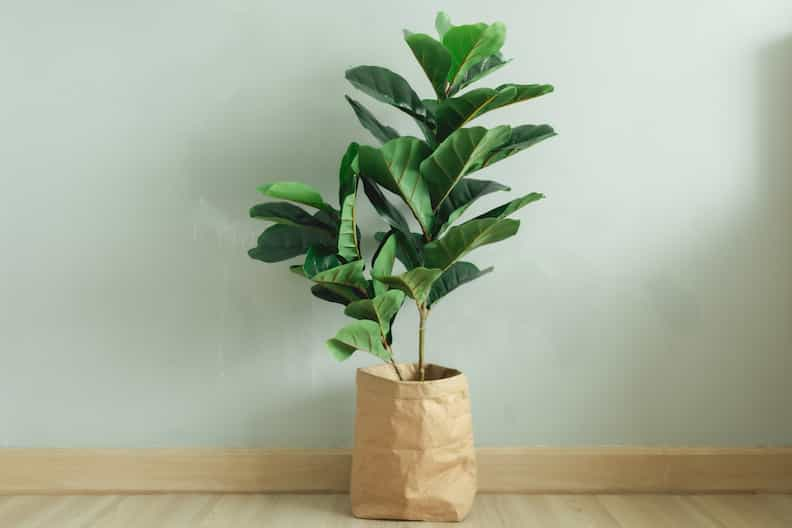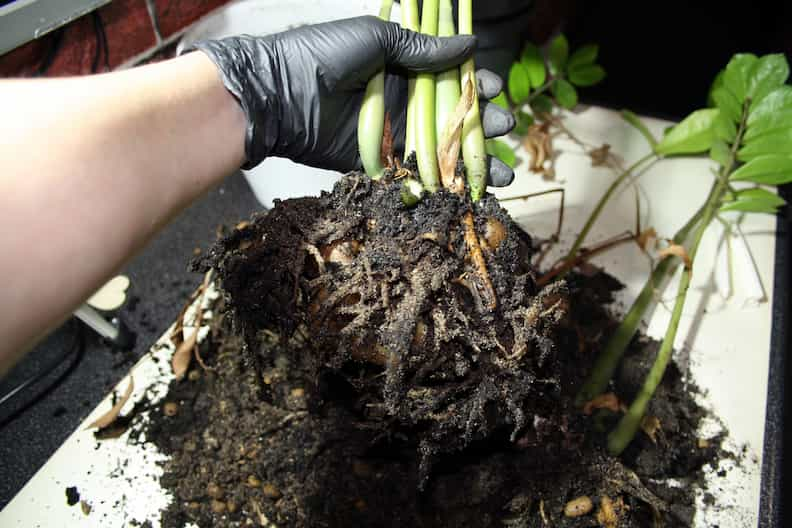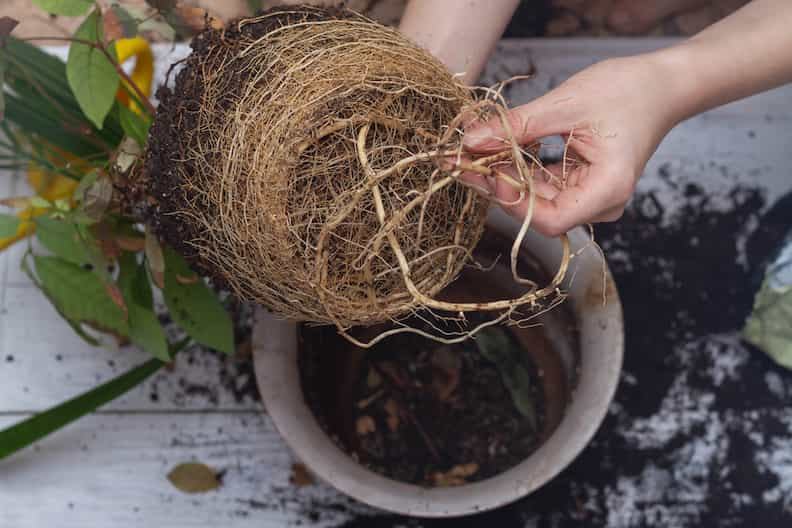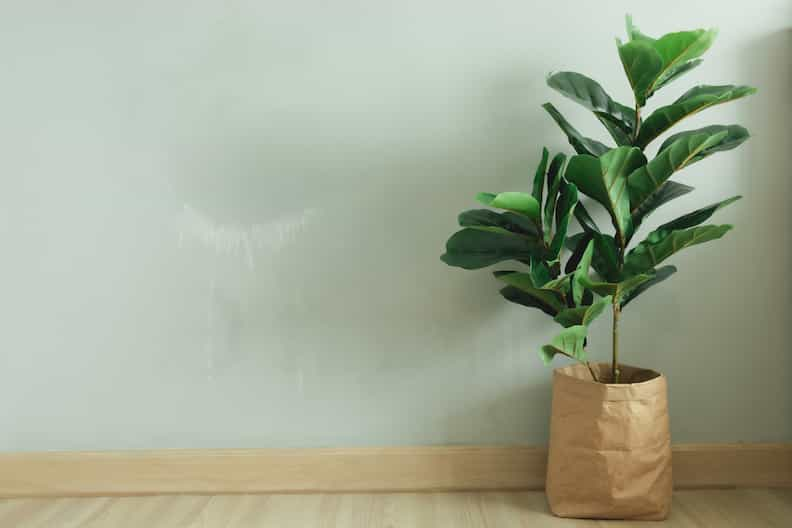Showing your fiddle leaf fig some love is what being a houseplant owner is all about. Unfortunately, too much care through, say, giving it more water than it likely needs is a fairly common cause of certain problems arising, one of which is your fiddle leaf fig developing root rot.
This is a disease that can affect any plant, though root rot in a fiddle leaf fig is something that this plant is particularly prone to. The condition is brought on by the plant sitting for long periods in soil that is too wet and soggy. The abundance of moisture and lack of air pockets in the soil causes decay to set in as the roots don’t get enough oxygen and start to die.
So if you have been watching your fiddle leaf fig slowly start to decline, there’s definitely a chance that it has a case of root rot. Fortunately, if caught early enough and if swift action is taken, it’s more than possible to reverse any damage, save the healthy roots and lead your fiddle leaf fig to recovery.
Keep reading to find out just what you should do if faced with this situation – and how to prevent root root happening again in future.

Table of Contents
What does root rot look like on fiddle leaf figs?
The leaves on a fiddle leaf fig with root rot will often form brown spots, but not always, so it’s best to actually check the roots. Signs of root rot on your fiddle leaf fig include heavy, compacted and wet soil with roots that are either brown or black, withered, mushy or, in extreme cases, completely rotted away.
Sometimes, you may actually notice red spots on your fiddle leaf fig first before they start to become more brown.
It’s good to keep in mind that even a fiddle leaf fig that seems healthy at first glance and that is in soil that is appropriately drying out can still have root rot issues. While you may not be very keen to take it out of its pot, at least when you do so the signs of root rot in a fiddle leaf fig will be fairly easy to identify.
What’s the difference between healthy fiddle leaf fig roots vs root rot?
The main difference between healthy fiddle leaf fig roots vs root rot is that the roots with root rot will be brown or black, very wet and mushy and even sometimes rotted away. Healthy roots are usually white, cream or yellow. They’re also much firmer and able to be moved, compared to slimy, non-pliable roots with root rot.
What’s difficult about root rot is that your fiddle leaf fig itself may show signs of distress, but these can be similar to what it does when faced with other issues. For example, brown spots on your fiddle leaf fig are a certain sign of a problem – but just what that problem is can vary.
This is why actually checking the roots and comparing them to what they should look like in a healthy fiddle leaf fig is the best way to know if root rot is the problem you’re facing.

What do healthy fiddle leaf fig roots look like?
Healthy roots on a fiddle leaf fig are usually bright white, cream, or yellow in color. Older roots that are getting thicker and older can turn shades of brown but will still usually be much lighter in color than ones with rot.
It is also important to note that healthy roots, while they can bend and be flexed will still be ‘crisp’ to a certain extent. If you bend them too far, they will snap and break. Roots that are rotting will usually just bend, twist and start to break apart or even turn to mush between your fingers.
In brief, healthy roots on a fiddle leaf fig, and most plants in general, look much different from the black slimy mess you are likely to find in a plant dealing with root rot. You’ll definitely be able to tell the difference if you’re facing a case of root rot in your plant.

How do you fix root rot in a fiddle leaf fig?
Fiddle leaf fig root rot occurs because there usually is too much moisture in the soil due to overwatering. There could have been damage caused to the root system somehow that made it more susceptible to poor watering and fertilizing routines.
However, there is a chance to save your fiddle leaf fig from root rot if you can act fast and follow these steps
- Remove your plant from its pot to inspect the root system. What do the roots look like? What is the soil in the pot like? Look for the signs of root rot mentioned above and if your fiddle leaf fig has root rot, then you will want to take immediate action to try and save your plant.
- Gently remove as much of the soil from the root ball as possible. If needed, you can rinse off the root ball with room temperature water to clean off the muddy dirt. Once it has been cleaned off you can more closely inspect the roots.
- Remove any roots you find that are brown or mushy with a sharp pair of pruning shears or scissors to prevent the rot from spreading to other areas of the root system. You will want to remove the worst of the damaged roots, but, if at all possible, you likewise want to save as much of the root ball as you can so the fiddle leaf fig can more easily grow new roots and recover.
- Choose a bigger pot for your plant. With the dead and rotting roots removed, it is now time to get a different pot for replanting your fiddle leaf fig. Choose a fiddle leaf fig planter that’s larger than the one previously and make sure you get one that has drainage holes in the bottom if at all possible. If that is not an option then you may want to add a layer of graven to the bottom of your container. An inch or two layer can help to improve the drainage and provide a buffer that keeps the roots out of any standing water that forms at the bottom of the pot.
- Check that the pot isn’t too big. While you want space in the pot for new roots to grow, you also do not want a pot that is too oversized either. Too much empty soil in the pot will mean water is retained longer and the risk of over watering again is much, much higher. Ideally, you need a pot that is just 4 to 6 inches larger in diameter than what your plant was already in or larger than the root ball now that the dead roots have been trimmed away.
- After repotting, move your plant to bright, indirect light. It is important to make sure that your fiddle leaf fig gets enough light. Even with proper watering and drainage, fiddle leaf figs can suffer from root rot if they’re not getting enough light. Keeping it near a window where it can get morning or evening sun for long periods or at least a couple of hours of midday sun, is a good idea.
- Water your fiddle leaf fig once. Make sure the water drains out of the holes at the bottom of the pot. After that, wait. Do not water again until the root system has been able to dry out fully. If you are unsure how moist the soil deeper in the pot is, consider investing in a moisture sensor so you can learn how fast it will dry out and how often and how much you should be watering your fiddle leaf fig.
Best soil for Fiddle Leaf Figs
Miracle-Gro Tropical Potting Mix
Light and well-draining (perfect for avoiding root rot) while being packed with just the right nutrients – that will feed your plant for up to six months. The best soil for keeping your fiddle leaf fig healthy and strong.
What is the best root rot fiddle leaf fig treatment?
The best treatment for a fiddle leaf fig with root rot is to replant it and remove the diseased roots. Changing watering habits may not be enough to save the plant if too much of the root system is dead and rotting as this can cause the rest of the root ball to become diseased and die as well.
In fact, while fiddle leaf figs don’t particularly like being repotted at first, a plant with root rot is one of the main triggers for when you should repot a fiddle leaf fig.

And once you’ve repotted it, changing your watering habits will be key. You should learn how often to water your fiddle leaf fig as it’s very likely that overwatering your fiddle leaf fig (potentially combined with other things, like a pot that was too small) caused the issue.
That’s why you should make sure you have a good understanding of your fiddle leaf fig’s water needs so it’s only getting as much moisture as it actually wants.
Related: 8 Proven Steps to Save an (Almost!) Dead Fiddle Leaf Fig
Can I treat fiddle leaf fig root rot with hydrogen peroxide?
Yes, in small quantities and with limited application, hydrogen peroxide can be used to help treat and fight root rot in fiddle leaf figs. You will want to use a very mild solution of about one tablespoon of medium strength peroxide to one cup of water.
This mix can be sprayed onto the roots to help kill the bacteria causing the fiddle leaf fig root rot. Apply the mix once the root ball has been trimmed, and it can help ensure the healthier roots left are as clean as possible.
Should I try a root supplement for fiddle leaf fig?
You can try adding a root supplement to your fiddle leaf fig’s soil to help keep the root system healthier, as they are known to work so are worth trying. Ultimately, though, the best thing you can do to protect your fiddle leaf fig against root system issues is to maintain proper water and oxygen levels.
The main reason that people put in root supplements and additives is to help promote good bacteria in the soil, so harmful bacteria cannot become established. This can be an added insurance policy against issues down the road if you want that extra layer of protection for your fiddle leaf fig – but it’s not strictly necessary.
Can a fiddle leaf recover from root rot?
A fiddle leaf fig with root can make a full recovery if you take action quickly and give it the space it needs to recover. Noting the signs early enough is important here, as saving as much of the root system as possible and preventing the spread of the bacteria to the healthy part of the root ball is critical.
If you do that, there’s every chance that your fiddle leaf fig will go back to its normal, thriving self.
It will, however, take time and a change to care routines and closer monitoring of the plant’s health for some time. In particular, keeping an eye on the amount of water it’s getting is going to be key.

What causes root rot in a fiddle leaf fig?
Root rot is caused by there being too much moisture in the soil because of overwatering. This results in the roots not being able to get enough oxygen and so they start to decay. While fiddle leaf fig roots also need water, there should always be dry to slightly damp soil around the roots rather than wet soil.
The issue with root rot in a fiddle leaf fig, as well as in potted plants, is that the bacteria causing the decay can spread through the soil quickly in such a confined space. This makes it easier for healthier parts of the root system to be damaged and die off and start to rot away as well.
In containers with poor drainage, the bacteria can get into the standing water and spread even faster, which is why good drainage is critical for fiddle leaf fig and pretty much all potted indoor plants.
This can be an issue for many plant owners, especially those who are new to the joys of growing fiddle leaf figs. They want to make sure it has enough water to grow, and they end up quickly over watering their plants. The pots cannot drain properly and are not allowed to dry out between watering. So, the plant sits in water and essentially drowns and begins to rot.
How to prevent root rot in a fiddle leaf fig?
The best way to prevent root rot in a fiddle leaf fig is to closely monitor your watering habits. Nearly all cases of root rot involve overwatering in some way. If you can prevent soggy soil and too much water staying in the pot, you can eliminate nearly all possibility of root rot in your fiddle leaf fig.
Many people love the look of the fiddle leaf fig, which is why it has long been a popular houseplant in many homes across the country. While it is an overall very hardy plant, it is susceptible to root issues, especially in the face of over watering and soggy oil conditions.
However, as we have seen, it is easy to avoid these issues and keep your fiddle leaf fig looking great. With proper watering and general care, your plants can grow and thrive and offer you all the wonderful benefits you are looking for in the first place.
Dealing with fiddle leaf fig root rot can be a challenge, but these tips will make it easier day in and day out. So, keep these tips in mind, be watchful for root rot issues, and enjoy your fiddle leaf fig like never before…just perhaps with some careful watering!

